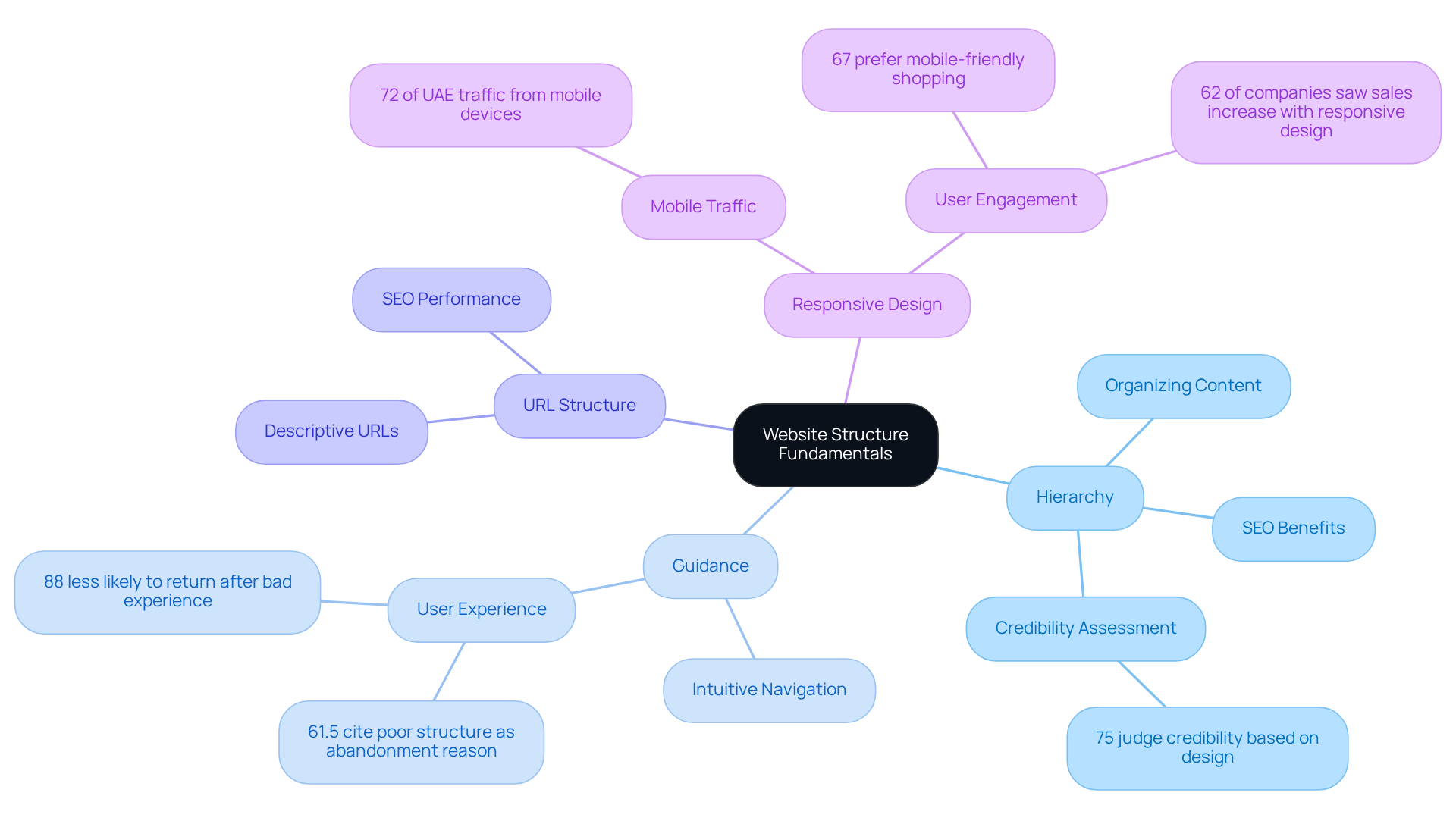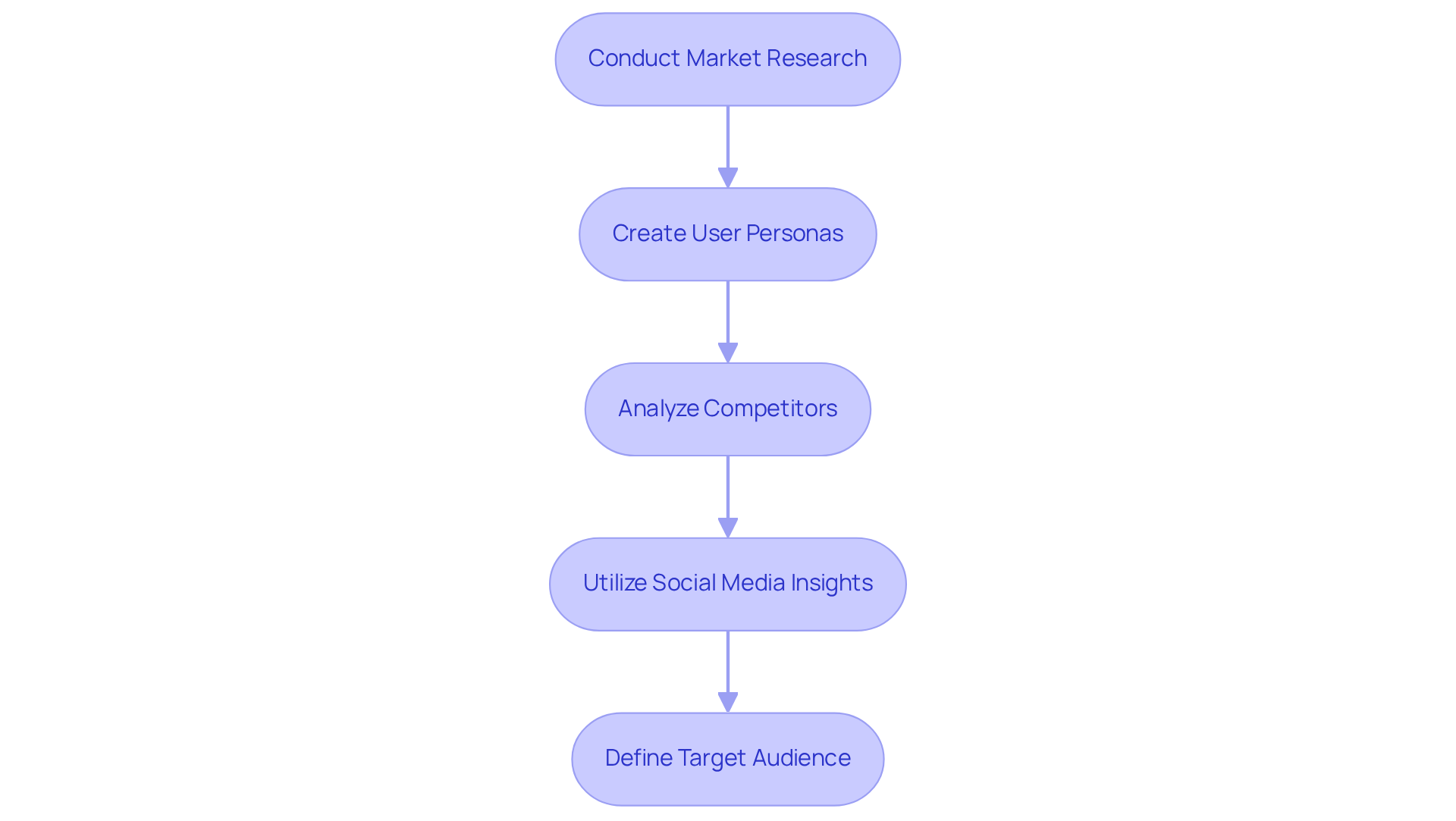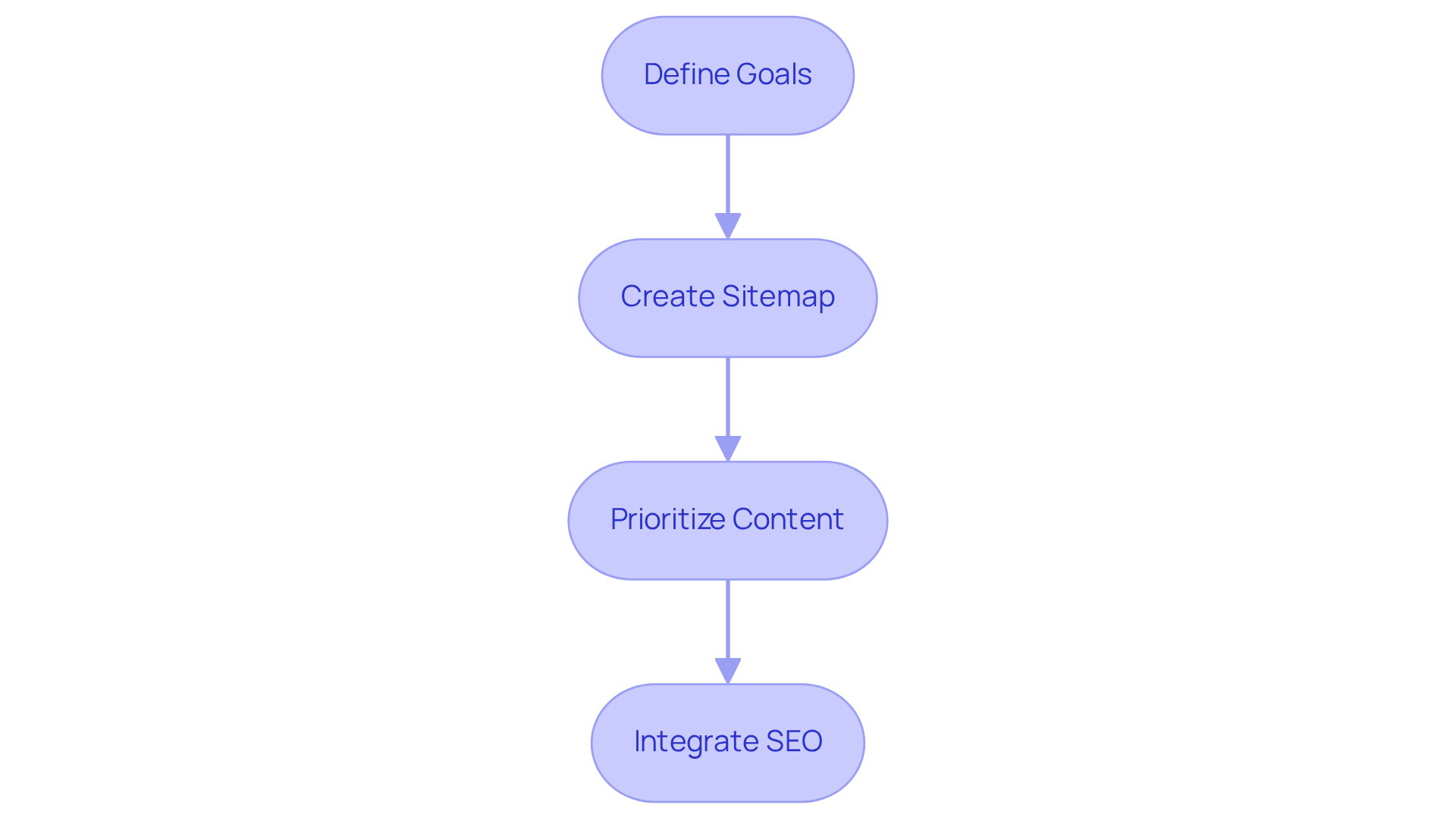Overview
In today's digital landscape, many startup founders grapple with the daunting task of mastering their website's structure. This challenge can often feel overwhelming, leaving them anxious about how to effectively engage visitors and enhance their online presence. Without a clear hierarchy, guidance, URL structure, and responsive design, the user experience may suffer, leading to frustration and disengagement. This not only impacts navigation but can also diminish credibility and trust among potential customers.
However, there is hope. By focusing on these essential elements, you can transform your website into a welcoming space that fosters connection and trust. A well-structured site not only facilitates smooth navigation but also enhances SEO performance, ultimately supporting your startup's success. Remember, you are not alone in this journey; many have faced similar challenges and have found solutions that work. Embracing these strategies will not only ease your worries but also empower you to create a site that resonates with your audience and reflects the heart of your startup.
Introduction
Mastering the structure of a website is a crucial yet often overlooked aspect for startups striving to establish a strong online presence. We understand that a well-organized site not only enhances user experience but also significantly boosts search engine visibility, making it an essential element for success. Yet, many entrepreneurs face the daunting complexities of creating an intuitive and efficient web architecture.
How can startups navigate these challenges to build a site that captivates visitors and drives conversions? This guide offers four essential steps to help startup founders master their website structure, ensuring a seamless experience for users and laying a solid foundation for growth.
- Define your website's purpose and goals.
- Create a logical hierarchy of content.
- Optimize for mobile and desktop users.
- Test and iterate on your design and structure.
Understand Website Structure Fundamentals
To truly master the structure of a site, it's important to first recognize the challenges that many face in this area. A disorganized site can lead to confusion and frustration for visitors, making it difficult for them to find what they need. This is where understanding key concepts becomes essential.
-
Hierarchy is a foundational element. Organizing content effectively is vital. Picture your homepage as a welcoming entry point that links to main categories, which then connect to subcategories and individual pages. This thoughtful framework not only guides visitors but also enhances SEO, as search engines favor a well-structured site and the overall structure of the site. As David Jenkin, a content writer, insightfully notes, "Three-quarters of individuals assess credibility based on web design," highlighting the importance of a well-organized hierarchy in building trust.
-
Next, consider the Guidance your site provides. A clear and intuitive navigation system is crucial for a positive user experience. Users should be able to find information quickly and easily. In fact, studies show that 61.5% of web designers recognize inadequate structure of a site as a leading cause of site abandonment. Furthermore, 88% of online shoppers are less likely to return to a site after a negative experience, underscoring the importance of efficient navigation in retaining visitors.
-
Another important aspect is URL Structure. Descriptive URLs that clearly reflect the content of the page are not just helpful for users; they also play a significant role in SEO performance. Search engines prioritize sites with clear and relevant URL structures, which can lead to improved rankings.
-
Responsive Design is non-negotiable in today’s digital landscape. With over 72% of internet traffic in the UAE coming from mobile devices as of 2025, ensuring your website is mobile-friendly is essential. A mobile-first strategy not only enhances user experience but also fosters engagement. Many individuals prefer purchasing on mobile-compatible platforms, with 67% expressing this preference. A case study even shows that implementing responsive mobile platforms has increased sales for 62% of companies, demonstrating the critical nature of this element for eCommerce success.
By mastering these fundamentals, you lay a strong foundation for the structure of a site, which is vital for enhancing visitor experience and boosting search engine visibility. Remember, fast-loading websites that load in one second can triple conversion rates compared to slower competitors, emphasizing the need for speed in website design. Embrace these insights, and you'll create a nurturing online environment that welcomes and retains your visitors.

Identify Your Target Audience
Identifying your target audience can feel overwhelming, but it’s a crucial step in your journey. Here are some nurturing steps to guide you:
-
Conduct Market Research: Begin by gathering insights through surveys, interviews, and analytics tools. This comprehensive data will help you understand your prospective customers’ demographics, preferences, and pain points. As George Kuhn wisely states, "Market research will allow you to make higher-level decisions about your startup." Recognizing these factors is essential for tailoring your offerings to meet their needs.
-
Create User Personas: Take the time to develop detailed profiles of your ideal customers, focusing on their goals, challenges, and interactions with technology. This practice not only clarifies who your audience is but also informs your design and marketing strategies. With 90% of startups facing failure, and 10% failing in the first year, it’s vital to understand your target audience to mitigate risks and foster success.
-
Analyze Competitors: Look closely at similar startups and their audience engagement strategies. By identifying gaps in their approaches, you can uncover opportunities for your startup to stand out and better meet user needs. A case study on "Customer Profiling through Market Research" illustrates how startups can optimize their advertising budgets by accurately profiling target customers.
-
Utilize Social Media Insights: Platforms like Facebook and LinkedIn offer valuable analytics that can deepen your understanding of who engages with your content. This data is instrumental in refining your audience profiles and enhancing your outreach efforts.
By clearly defining your target audience through these nurturing methods, you can create a structure of site that aligns with their needs and preferences. This approach ultimately drives improved engagement and conversions, paving the way for your startup’s success.

Plan Your Website Structure Strategically
When it comes to planning your website structure, it’s essential to approach it with care and intention. Many startup founders face the challenge of creating a site that truly meets their needs and resonates with their audience. This can lead to feelings of frustration and overwhelm, especially when considering the potential impact on your business.
To address this, start by defining your goals. What do you genuinely want your website to achieve? Whether it’s generating leads, selling products, or sharing valuable information, your objectives will influence the entire structure of the site. Remember, a well-defined goal is not just a checkbox; it’s a guiding light for your design and functionality choices. It’s worth noting that companies can lose up to 35% of potential income due to a poor user experience, underscoring the importance of this foundational step.
Next, consider creating a sitemap. Visualizing your website's architecture can be incredibly helpful. By detailing main pages, subpages, and their connections, you create a roadmap for development. This isn’t just about organization; it’s about ensuring that every element serves a purpose and enhances usability. Effective sitemaps can significantly improve site performance, making this step vital for startups like yours.
Now, let’s talk about content prioritization. It’s crucial to identify what content matters most and make it easily accessible. A top-down approach works wonders here—place the most important information at the forefront. This strategy not only aids navigation but also aligns with best practices in experience design, where clarity and accessibility are key. With over half of all web traffic coming from mobile devices, optimizing your content for mobile is essential.
Finally, don’t overlook the importance of SEO best practices. Thoughtfully integrating keywords and metadata can greatly enhance your search visibility. The structure of the site should support these efforts by including relevant keywords in URLs and headings. As Forrester Research highlights, investing in user experience can yield significant returns, emphasizing the financial benefits of prioritizing SEO in your digital strategy.
By carefully organizing your website layout, you’re not just creating a site; you’re fostering a smooth browsing experience for your visitors. This thoughtful approach can lead to enhanced interaction and overall performance, ultimately supporting your journey as a tech startup founder.

Optimize Navigation and Internal Linking
Navigating a website can often feel overwhelming, especially for those of us trying to build a startup. When users encounter complex navigation, it can lead to frustration and a sense of being lost. This not only affects their experience but can also hinder your goals for engagement and conversion.
To help alleviate this challenge, consider these supportive strategies:
- Simplify Navigation Menus: Aim to keep your menus concise and organized. Use clear labels that genuinely reflect the content of the pages they link to, making it easier for users to find what they need.
- Implement Breadcrumbs: Breadcrumbs are a wonderful tool that assists individuals in understanding their position within your platform. They enable straightforward backtracking, providing a sense of security as users navigate your site.
- Utilize Internal Links Effectively: By connecting relevant content within your site, you can guide visitors to explore further information. This not only enhances their experience but also supports your SEO efforts, creating a win-win situation.
- Test Navigation: Gathering feedback through usability testing is essential. By observing individual behavior and preferences, you can make thoughtful modifications that truly resonate with your users.
By optimizing the structure of the site and internal linking, you foster a seamless experience for users. This not only encourages them to explore your site further but also increases the likelihood of conversions, helping you achieve your startup goals with greater ease.

Conclusion
Mastering the structure of a website can feel overwhelming for startups striving to establish a meaningful online presence. It's essential to recognize that understanding and implementing key elements—like hierarchy, navigation, URL structure, and responsive design—can significantly enhance user experience and improve search engine visibility. A well-structured site not only draws visitors in but also fosters trust and credibility, which are vital for long-term success.
Throughout this journey, identifying your target audience stands out as a foundational step in creating an effective website. Engaging in thorough market research, developing user personas, analyzing competitors, and tapping into social media insights are crucial methods for truly understanding your audience's needs. Moreover, strategically planning your website's structure, optimizing navigation, and implementing effective internal linking can further contribute to a seamless user experience, ultimately driving engagement and conversions.
In conclusion, the significance of a well-structured website cannot be overstated. It serves as the backbone of your startup’s online strategy, influencing everything from user retention to SEO performance. By embracing these best practices, you not only position your startup for immediate success but also lay the groundwork for sustainable growth in a competitive digital landscape. Take action today to refine your website structure, ensuring that it resonates with your audience and meets their needs effectively. Remember, you're not alone in this journey; together, we can navigate the path to success.
Frequently Asked Questions
Why is understanding website structure important?
Understanding website structure is crucial because a disorganized site can confuse visitors, making it difficult for them to find information. A well-structured site enhances user experience and improves SEO, as search engines favor organized content.
What is the role of hierarchy in website structure?
Hierarchy is foundational in website structure. It involves organizing content effectively, where the homepage serves as an entry point linking to main categories, subcategories, and individual pages. This framework guides visitors and builds trust, as a well-organized hierarchy is linked to credibility.
How does site navigation affect user experience?
Clear and intuitive navigation is essential for a positive user experience. Users should be able to find information quickly and easily. Inadequate site structure is a leading cause of site abandonment, and negative experiences can deter online shoppers from returning.
What is the significance of URL structure?
Descriptive URLs that reflect the content of the page are important for both users and SEO. Clear and relevant URL structures help search engines prioritize sites, leading to improved rankings.
Why is responsive design critical for websites today?
Responsive design is essential as a significant portion of internet traffic comes from mobile devices. A mobile-friendly website enhances user experience and engagement, with many users preferring to shop on mobile-compatible platforms.
How does website speed impact conversion rates?
Fast-loading websites that load in one second can triple conversion rates compared to slower competitors. Therefore, speed is a critical factor in website design that affects visitor retention and sales.
What are the benefits of mastering website structure fundamentals?
Mastering website structure fundamentals lays a strong foundation for enhancing visitor experience and boosting search engine visibility, ultimately creating a welcoming online environment that retains visitors.




